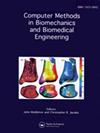An efficient deep learning approach for automatic speech recognition using EEG signals.
IF 1.7
4区 医学
Q3 COMPUTER SCIENCE, INTERDISCIPLINARY APPLICATIONS
Computer Methods in Biomechanics and Biomedical Engineering
Pub Date : 2025-02-16
DOI:10.1080/10255842.2025.2456982
引用次数: 0
Abstract
Electroencephalogram (EEG) signals enhance human-machine interaction but pose challenges in speech recognition due to noise and complexity. This study proposes an Efficient Deep Learning Approach (EDLA) integrating the Gannet Optimization Algorithm (GOA) and Elman Recurrent Neural Network (ERNN) for speaker identification. EEG data is preprocessed using a Savitzky-Golay filter, and key features are selected via recursive feature elimination. Evaluated on the Kara One dataset, EDLA achieves 95.2% accuracy, outperforming baseline methods. This framework advances EEG based speech recognition aiding brain-computer interfaces and assistive technologies for individuals with speech disorders.
基于脑电信号的语音自动识别的高效深度学习方法。
脑电图(EEG)信号增强了人机交互,但由于噪声和复杂性给语音识别带来了挑战。本研究提出一种整合Gannet优化算法(GOA)和Elman递归神经网络(ERNN)的高效深度学习方法(EDLA)用于说话人识别。采用Savitzky-Golay滤波对脑电数据进行预处理,并通过递归特征消去选择关键特征。在Kara One数据集上进行评估,EDLA的准确率达到95.2%,优于基线方法。该框架推进了基于脑电图的语音识别辅助脑机接口和言语障碍患者的辅助技术。
本文章由计算机程序翻译,如有差异,请以英文原文为准。
求助全文
约1分钟内获得全文
求助全文
来源期刊
CiteScore
4.10
自引率
6.20%
发文量
179
审稿时长
4-8 weeks
期刊介绍:
The primary aims of Computer Methods in Biomechanics and Biomedical Engineering are to provide a means of communicating the advances being made in the areas of biomechanics and biomedical engineering and to stimulate interest in the continually emerging computer based technologies which are being applied in these multidisciplinary subjects. Computer Methods in Biomechanics and Biomedical Engineering will also provide a focus for the importance of integrating the disciplines of engineering with medical technology and clinical expertise. Such integration will have a major impact on health care in the future.

 求助内容:
求助内容: 应助结果提醒方式:
应助结果提醒方式:


